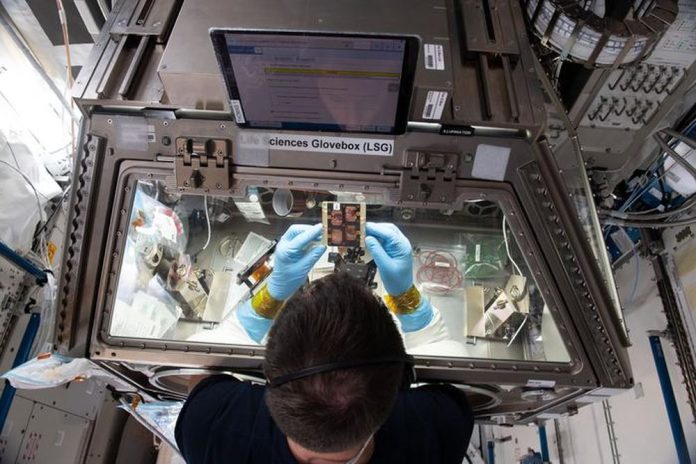
One of the hazards astronauts must contend with is muscle loss. The more time they spend in a microgravity environment, the more muscle loss they suffer.
Astronauts use exercise to counter the effects of muscle atrophy, but it’s not a perfect solution.
Researchers want to develop drugs to help, and understanding the muscle-loss process in space is a critical first step.
In the early days of space travel, researchers weren’t certain what effects microgravity had on astronauts.
As the length of space missions grew and scientific monitoring became more prevalent, researchers gained a better understanding of the problem.
After the Skylab missions in 1973 and 1974, researchers acquired better data and began to reach some conclusions.
It was clear that microgravity contributed to a host of health problems, and muscle atrophy was among them.
Many of the problems astronauts suffer mimic the same problems stemming from aging.
“Space is a really unique environment that accelerates qualities associated with aging and also impairs many healthy processes,” said Ngan Huang, an associate professor at Stanford University.
“Astronauts come back with muscle atrophy, or a reduction of muscle function, because the muscle isn’t being actively used in the absence of gravity.
As space travel becomes more common and available to civilians, it’s important to understand what happens to our muscle in microgravity.”
Huang is the co-author of new research published in the journal Stem Cell Reports. The study is “Skeletal muscle-on-a-chip in microgravity as a platform for regeneration modeling and drug screening.”
Age-related muscle loss is called sarcopenia. Many factors, including immobility, hormonal changes, and even nutrition, contribute to sarcopenia.
Currently, there aren’t any FDA-approved drugs to treat the condition, so exercise, lifestyle, and nutrition are the only ways to treat it. Exercise is critical for astronauts in their struggle against muscle loss.
However, space for exercise equipment is limited on the ISS. An effective medication to treat astronaut sarcopenia would be a huge boon.
In this new research, the researchers grew live muscle cells on scaffolds on tiny chips and then sent them for study in microgravity aboard the ISS. The cells grew for seven days under the watchful eyes of astronauts and were exposed to a pair of used to counteract sarcopenia and enhance muscle regeneration.
Then, they compared the microgravity muscle cells to ones grown under normal gravity in a lab here on Earth.
The results showed that the microgravity muscle cells had impaired muscle fibre formation, differences in gene activity, and differences in their protein profiles.
Muscle tubes, or myotubes, are precursors to muscle fibres. The study results showed reduced myotube length and width, as well as a reduced fusion index. The fusion index basically tells researchers how many muscle cell nuclei are present.
The mitochondria generate most of a cell’s energy, and the results showed that genes affecting their function were compromised. Since muscles have such high metabolic function, any impairment to mitochondria will play out in reduced muscle regeneration.
Results also showed that genes associated with forming fat were bolstered. The researchers say the combined effect takes a large toll on muscle regeneration in microgravity.
Protein profiles are like snapshots of what cellular machinery is doing at a particular time. They reveal critical information about the cell’s function and health. In this research, the team examined 200 different proteins.
The results showed that five proteins were produced in greater abundance. Two of those are associated with chronic inflammation, and one is “a biomarker for mitochondrial dysfunction and cellular senescence.”
Four of the proteins showed reduced abundance. One of those is “an important player in the maintenance of muscle and myogenesis,” the researchers write in their paper.
Overall, the changes the muscle cells underwent shared similarities with changes induced by aging.
“We think our research on muscle chips in microgravity may have broader implications on sarcopenia,” says Huang. “Sarcopenia usually takes decades to develop on Earth, and we think that microgravity may have some ability to accelerate the disease process in orders of days.”
The research also helped understand the role drugs could play. “We next used the muscle-on-a-chip platform to perform proof-of-concept drug screening studies,” the researchers write. They exposed the cells to drugs used to counteract sarcopenia and enhance muscle regeneration.
Geneticists use the terms down-regulation and up-regulation to describe negative and positive effects on gene expression. They found that 286 genes were down-regulated in microgravity. Of those, 200 showed a positive response to drug treatment and similar expression levels to cells in normal gravity.
“In conclusion, we show that engineered muscle-on-a-chip bioconstructs exposed to microgravity induced prominent changes to their transcriptome that mimic aspects of impaired myogenesis,” the authors write.
Space research is difficult and resource-intensive, so the researchers intend to continue their work using equipment that mimics microgravity to dig deeper into the issue here on Earth. In 2025, the muscles-on-a-chip are scheduled for another space flight. That experiment will help to identify more drugs that can combat muscle loss.
The benefits of this research extend beyond just muscle loss. “This concept of engineered tissue chip platform in microgravity is a potentially transformative tool that could allow us to study a variety of diseases and do drug screening without animal or human subjects,” says Huang.
The authors conclude in their paper, “This work further highlights the utility of microgravity as a unique environment for drug discovery.”
If you care about muscle, please read studies about factors that can cause muscle weakness in older people, and scientists find a way to reverse high blood sugar and muscle loss.
For more information about health, please see recent studies about an easy, cheap way to maintain muscles, and results showing these vegetables essential for your muscle strength.
Written by Evan Gough/Universe Today.



